Tasmanian Tiger (Thylacine)
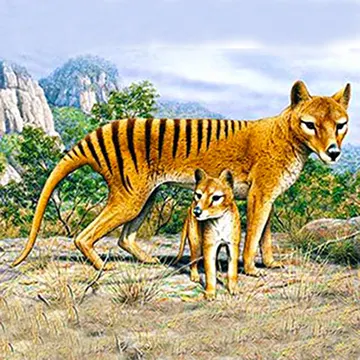
Contents
What is a Tasmanian Tiger
The Tasmanian tiger, also known as the thylacine, was a large stripped carnivorous marsupial resembling a large dog. It had distinctive tiger-like stripes and a stiff awkward looking tail. However, despite its canine-like appearance, this extinct predator was more closely related to modern-day kangaroos and koalas.
Unfortunately, human hunting and habitat destruction led to its extinction. The last Tasmanian tiger died of neglect in a zoo on 7 September 1936—it froze to death.
Tasmanian Tiger Description
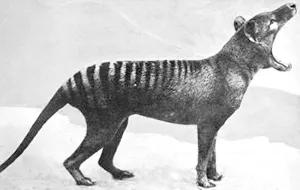
Photo: Tasmanian Tiger with mouth wide open
The Tasmanian tiger was an apex predator with a slender body about 1 meter long, with a stiff tail measuring an additional 0.5 meters. It weighed approximately 27 kilograms. It had short, yellowish-brown fur and 15 to 20 prominent dark brown stripes across its back and rump. It had a broad head, upright ears, and large black eyes with elliptical pupils (like a cat) and excellent night vision. Its fox-like muzzle housed an impressive jaw that could open 90 degrees—far wider than a dog's. When threatened, it displayed its 46 teeth in a fearsome yawn, though its weak bite limited it to smaller prey under 5kg.
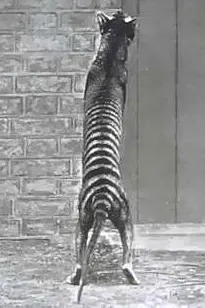
Photo: Tasmanian Tiger on hind legs
With longer hind legs than front legs, the Tasmanian tiger had a stiff, awkward gait and could only manage a slow trot. Uniquely, it could stand upright and even perform short bipedal hops like a kangaroo when startled. Its rigid tail provided support, but it couldn't wag. Unlike most canines, its flexible forearms allowed it to rotate its paws upward, aiding in ambush attacks but making fast chases difficult. he Tasmanian tiger was a quiet animal, emitting only a low growl when irritated, whining to communicate with others and coughing or barking to signal its presence when hunting.
Interestingly, he male Tasmanian tiger also had a pouch, but his pouch was only for storing its scrotum and testicles! This feature was unique among marsupials. The female Tasmanian tiger had a backward-facing pouch in which it raised a litter of up to four babies at a time.
The Tasmanian tiger's scientific name is Thylacinus cynocephalis, meaning wolf-headed pouched dog. Its other names are Thylacine (pronounced thigh-la-sin), and Tasmanian wolf.
Where Did Tasmanian Tigers Live?
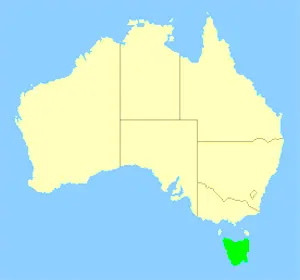
Photo: Tasmanian Tiger Distribution Map
The Tasmanian Tiger (Thylacine) was originally widespread across Australia, New Guinea, and Tasmania, living in open forests, wetlands, and grasslands. However, due to competition with dingoes, they disappeared from mainland Australia around 2,000 years ago, surviving only in Tasmania (coloured green on the map) until they were wiped out after European settlement. The Tasmanian tiger finally becoming extinct in the early twentieth century.
What Did the Tasmanian Tiger Eat?
The Tasmanian tiger was a nocturnal ambush hunter that ate small animals such as wallabies, bandicoots, possums and birds. It was a specialised eater and preferred soft body tissue such as the liver, kidneys, heart and lungs, and soft flesh.
Although the Tasmanian tiger was about the size of a dog, it did not hunt down large prey. This is because, even though it had a large mouth with jaws that could open almost 90 degrees, its jaws and skull were weak, and its mouth wasn't strong enough to handle the stresses of pulling down large prey such as a kangaroo or wombat.
Tasmanian Tiger Reproduction & Life Cycle Tasmanian Tiger Pouch, Teats, Penis & Babies
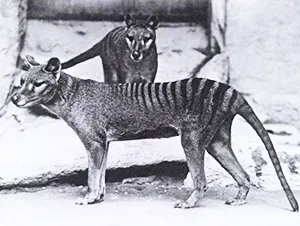
Photo: Pair of Tasmanian Tigers
Very little is known about the reproductive and mating characteristics of the Tasmanian tiger. It is assumed that they bred between winter and spring once a year. The female Tasmanian tiger had a backwards-facing pouch with four teats inside. It raised a litter of up to four babies at a time. The male Tasmanian tiger had a bifurcated or two-pronged penis, similar to a koala, located behind its scrotum. The male Tasmanian tiger also had a pouch for storing its scrotum and testicles!
It is estimated that the gestation period of the young inside the mother varied from 21 to 35 days, after which the female gave birth to up to four offspring. At birth, a baby called a joey, was about the size of a jellybean, hairless, blind, with no ears and only tiny stumpy limbs. Once it has exited the mother's birth canal, the joey uses its sense of smell and strong arms to crawl to the safety of her pouch. There, the joey attached itself to one of its mother’s four nipples. Her young remained in her pouch for 3 to 4½ months before they left the mother's pouch and ventured outside. Juveniles remained with their mother for about 12 months before leaving the family unit to lead independent lives.
The life expectancy of a Tasmanian tiger was about 5 to 7 years.
New research suggests that the thylacine population was severely inbred, with little DNA variation within the species. This may be a result of their isolation on the relatively small island of Tasmania.
How the Last Wild Tasmanian Tiger Was Killed
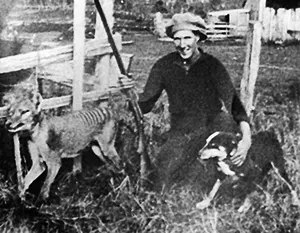
Photo: The Last Wild Tasmanian Tiger Shot
The last wild Tasmanian tiger was shot dead on 6 May 1930 by Wilf Batty, a farmer from Mawbanna in northeast Tasmania. Wilf claimed that the Tasmanian tiger was killing chickens. When Wilf brought the dead thylacine's body home, his dogs fled and didn't return for three days. (The dog does look frightened in the photograph). Since 1930, many people have claimed to have sighted Tasmanian tigers in the wild, but these sightings have never been confirmed.
How the World's Last Tasmanian Tiger Died
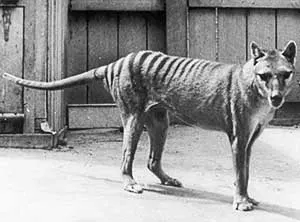
Photo: The last Tasmanian Tiger that ever lived
The last Tasmanian tiger became extinct on 7 September 1936. On that day, the last Tasmanian tiger in the world (see photo) died from exposure to the cold at the Beaumaris Zoo in Hobart, Tasmania. The zoo-keeper forgot to lock the animal in its shelter overnight, and the unfortunate animal froze to death on a cold concert floor. There were no news reports to record the animal’s passing. Its body was just thrown away. What an ignominious end to such a unique and splendid animal!
The Tasmanian tiger had survived millions of years. European settlers killed the beautiful the Tasmanian tiger in just 150 years. It became extinct.
Why The Tasmanian Tiger Became Extinct
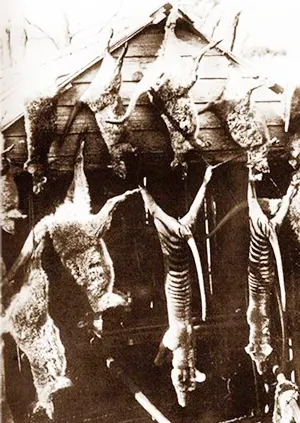
Photo: Carcasses of Tasmanian Tiger Killed
The Tasmanian tiger became extinct because of excessive hunting, habitat loss, and diseases introduced by European settlers. The animal was also falsely accused of being a sheep killer, and both private and government bounty schemes were introduced to eradicate them.
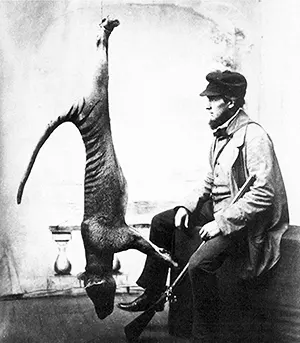
Photo: Bounty Hunter with his prize
The fur trade also contributed to their demise. Many Tasmanian tigers were killed, and their pelts made into waistcoats. And many other animals, such as possums, wallabies and platypuses that constituted the Tasmanian tiger’s diet, were also killed reducing the Tasmanian tigers’ food sources.
Furthermore, extensive competition from introduced carnivores such as cats and dogs directly affected the availability of smaller prey, which the Tasmanian tiger exclusively hunted. Introduced animals also carried diseases, such as Distemper, to which the Tasmanian tiger had no resistance. Habitat loss due to human actions further impacted their survival. Over 200 of these animals were captured and sold to zoos and circuses, while a further 500 were killed as specimens for museums and universities.
The Tasmanian government finally listed the Tasmanian tiger as a protected species on 10 July 1936, just 57 days before the last Tasmanian tiger died, and the species became extinct.
The Tasmanian Tiger Falsely Accused
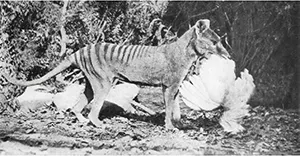
This photograph from 1921 purporting to show a Tasmanian tiger attacking chickens was widely circulated to stir the public. But, by this time, it was rarely seen and was already close to extinction.
Actually, this photograph is fake. The tiger was a stuffed specimen from an exhibit, with a dead chicken placed in its mouth. In the original uncropped photograph, below, you can see dead branches placed in front of fencing and congregated iron sheets to make it appear as though the photograph was taken in the wild.

Tasmanian Tiger Predators & Threats
The adult Tasmanian Tiger was a formidable apex predator. It had no native animals that would attack it. However, domestic dogs and cats introduced by European settlers changed its dominance. However, the most significant predators that caused the extinction of the Tasmanian tiger were humans, who indiscriminately killed these majestic creatures and drove them to extinction.
25 Tasmanian Tiger Facts
- The Tasmanian tiger got its name because of the tiger-like stripes on its back and tail.
- Actually, it looked more like a dog or wolf. That's why it was also called the Tasmanian wolf.
- Its closest living relative today is the small insectivorous numbat, with its hallmark black stripes.
- The Tasmanian tiger was the largest carnivorous marsupial in the world.
- It was about 1.5m long from its nose to the tip of its stiff tail.
- The Tasmanian tiger lived in open forests and grasslands.
- It had pupils like a cat's.
- This was well suited to its nocturnal behaviour. It was only seen after dark.
- It had a coughing bark when hunting or excited.
- The Tasmanian tiger had unusual legs. Its hind legs were longer than its front legs.
- It had a stiff tail similar to a kangaroo. It couldn't wag its tail.
- This gave it an awkward walk and an ungainly trot.
- The Tasmanian tiger rarely moved fast, preferring a leisurely walk or trot to a sprint.
- It could also hop short distances like a kangaroo.
- The Tasmanian tiger had a huge mouth with 46 teeth.
- But it only hunted small prey because it had weak jaws and jaw muscles.
- It was an ambush predator, like a cat.
- When threatened, it opened its mouth wide, showing off its impressive teeth.
- The female had a rear-facing pouch.
- The male also had a pouch, in which it stored its scrotum and testicles!
- The Tasmanian tiger was once found throughout Australia.
- It became extinct on the mainland about 2,000 years ago, possibly due to the dingo.
- It survives on the island of Tasmanian, until white settlers killed them off.
- The last Tasmanian tiger became extinct in 1936.
- Two weeks before laws were passed to protect it.
All Rights Reserved. (Last Updated: May 08, 2025)

